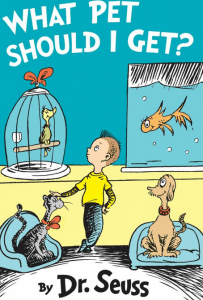 Not only has Harper Lee been published many years since her last book, but so too Dr. Seuss. Image from the page at WaPo and at Amazon.
Not only has Harper Lee been published many years since her last book, but so too Dr. Seuss. Image from the page at WaPo and at Amazon.
A newly discovered Dr. Seuss book goes on sale this week, 25 years after the beloved author’s last work, “Oh, The Places You’ll Go!”
“What Pet Should I Get?” tells the story of a brother and sister grappling with this fun question during a trip to the pet store. The manuscript and illustrations were discovered by Theodor Geisel’s (Dr. Seuss’s real name) widow at their home shortly after his death in 1991 and put aside. Two years ago, his widow and longtime secretary rediscovered them. Lucky for us.
Paleolithic dentistry unveiled:
Much has changed since the Paleolithic era — the invention of agriculture, the advent of organized religion, the rise and fall of civilizations — but one fact hasn’t: people got cavities then, as now. And before the advent of local anesthetic, the process of treating them sounds fairly miserable.
In a study published in the journal Scientific Reports last week, researchers examine the earliest known evidence that humans treated dental caries, better known (and deplored) as cavities.
Because this discovery predates the written word, we’ll never know for sure whether Paleolithic people dreaded seeing the dentist the way their modern descendants do. But based on the description of the treated tooth, the process had to be unpleasant.
Kirsten Powers, on Planned Parenthood:
This is stomach-turning stuff. But the problem here is not one of tone. It’s the crushing. It’s the organ harvesting of fetuses that abortion-rights activists want us to believe have no more moral value than a fingernail. It’s the lie that these are not human beings worthy of protection. There is no nice way to talk about this. As my friend and formerObama White House staffer Michael Wear tweeted, “It should bother us as a society that we have use for aborted human organs, but not the baby that provides them.”
Richards worked to discredit the video by complaining it was “heavily edited.” But the nearly three-hour unedited video — a nauseating journey through the inner workings of the abortion industry — was posted at the same time as the edited video. Richards intoned menacingly that the video was “secretly recorded.” So what? When Mitt Romney was caught by “secret video” making his 47% remarks, the means of attaining the information was not the focus of the story.
(CNN)There are elements of Middle-earth near a French village — though how deep they go is anyone’s guess.
In 1916, a 24-year-old British soldier named J.R.R. Tolkien went off to fight in World War I. He was stationed near the village of Bouzincourt, took part in the nearby Battle of the Somme and writes about the area in his diaries.
Jeff Gusky, an explorer and photographer who maintains a site called “The Hidden World of World War I,” believes Tolkien may have visited Bouzincourt’s caves, places where hundreds of soldiers took refuge during the Somme — and that some of his impressions ended up in “The Lord of the Rings.”
“I feel that this is the place,” Gusky said. “It’s so raw and unchanged from a hundred years ago.”
Tolkien scholar John Garth isn’t so sure.
Karen, a wedding, and the importance of vows:
But the thing that struck me, the thing that has stayed with me, the thing that caused tears to stream down my face was when Robert asked God to deal fiercely with him should he ever break his vows to Jasmine.
Oh. My. Gosh.
I can’t even imagine asking God to ever deal fiercely with me. I’ve spent a lifetime hoping, praying God would never deal fiercely with me.
But here was a man in love standing in front of a woman he loves asking God to punish him if he ever deserted her for any reason.
Can you even imagine it?
This in a country where half of all marriages end in divorce.
I wonder if all marriages wouldn’t be far more successful if we all took a more Robert-like approach to what it means to take an oath before God. Robert is keenly aware that his oath wasn’t just to Jasmine but to God as well.
Marco della Cava, whoa there!
SAN FRANCISCO — Don’t send your old clunker of a retro-mobile to the automotive junk yard just yet. It may be the safest machine on the road.
In an article published Tuesday, Wired magazine reports on how it engaged two hackers to see if they could take control of a Jeep Cherokee from the comfort of their living room while writer Andy Greenberg sat nervously at the wheel while the SUV cruised the highway at 70 mph.
Mission accomplished, terrifyingly so. The security experts, Charlie Miller and Chris Valasek, accessed the Jeep’s computer brain through its Uconnect infotainment system and rewrote the firmware to plant their malicious code. Once in, the duo began blasting hip-hop through the stereo system, turned the AC to maximum and, ultimately, killed the transmission and brakes.
Greenberg was unharmed in the demonstration, which took place on a highway in St. Louis, but eventually wound up stranded in a ditch. But the experiment highlights a concern that often isn’t addressed head-on in the growing excitement over the prospect of roads dominated by either autonomous or heavily driver-assisted vehicles.
A splendid romp through the “ugly” babies of Medieval art (and the homuncular Jesus — little man) to the chubby cute babies of the Renaissance.
We can break down the following two reasons for the man-babies of medieval art:
- Most of those medieval babies were depictions of Jesus. The concept of the homuncular Jesus affected how children were portrayed.Medieval portraits of children were usually commissioned by churches. And that made the range of subjects limited to Jesus and a few other biblical babies. Medieval concepts of Jesus were deeply influenced by the homunculus, which literally means little man. “There’s the idea that Jesus was perfectly formed and unchanged,” Averett says, “and if you combine that with Byzantine painting, it became a standard way to depict Jesus. In some of these images, it looks like he had male pattern baldness.”
A good and fun quiz for you from WaPo.
Whitney is part of a growing movement of autistic adults who are finding a sense of community, identity and purpose in a diagnosis that most people greet with dread. These “neurodiversity” activists contend that autism — and other brain afflictions such as dyslexia and attention deficit hyperactivity disorder — ought to be treated not as a scourge to be eradicated but rather as a difference to be understood and accepted.
The movement is not new. But it has gained a foothold in the cultural mainstream as the discredited debate over autism-causing vaccines has subsided and the voices of autistic adults have emerged, amplified by social media and the blogosphere.
“The new autistic person is being born in media, and it’s someone who is very empowered, even if they need a keyboard to speak,” said Steve Silberman, a journalist and author of “NeuroTribes: The Legacy of Autism and the Future of Neurodiversity,” a book coming out next month.
WILMINGTON, Del. — What if a blood sample taken by a family physician could diagnose breast cancer months — or even years — before a woman feels the first lump in her chest?
Now imagine if that diagnoses also came with a treatment plan so well-tailored to a patient’s genetic makeup that it could eliminate the guesswork involved in early chemotherapy and radiation used today.
“Early diagnoses and faster routes to effective treatment would mean more people could survive the disease and have a much better quality of life,” entrepreneur Jeb Connor said. “A test like this has the potential to change patient care as we know it.”
Connor and Adam Marsh, an associate professor at the University of Delaware, say they have found the key that could someday make those tests readily available.
Imagine this:
You’re flying from Frankfurt to Los Angeles with a stopover at John F. Kennedy International Airport (JFK) in New York. You’ve just spent more than 8 hours crammed into a kennel of a seat, sweating alongside over 200other passengers and you would like nothing more than a shower and maybe a private room in which to sit and watch some TV while you wait for your next flight. Sounds nice, right?
Well, if you’re a four-legged creature you may soon be privileged enough to receive such luxuries at JFK’s upcoming $48 million airport facility for animals. It comes equipped with flat screen TVs, climate-controlled stalls with showers, splashing pools and doggie hotel suites, according to the Associated Press. “The animal terminal will set new international airport standards for comprehensive veterinary, kenneling and quarantine services,” its founder John J. Cuticelli Jr. said in a statement, according to CNN.
That’s right, a luxury airport terminal for animals.











